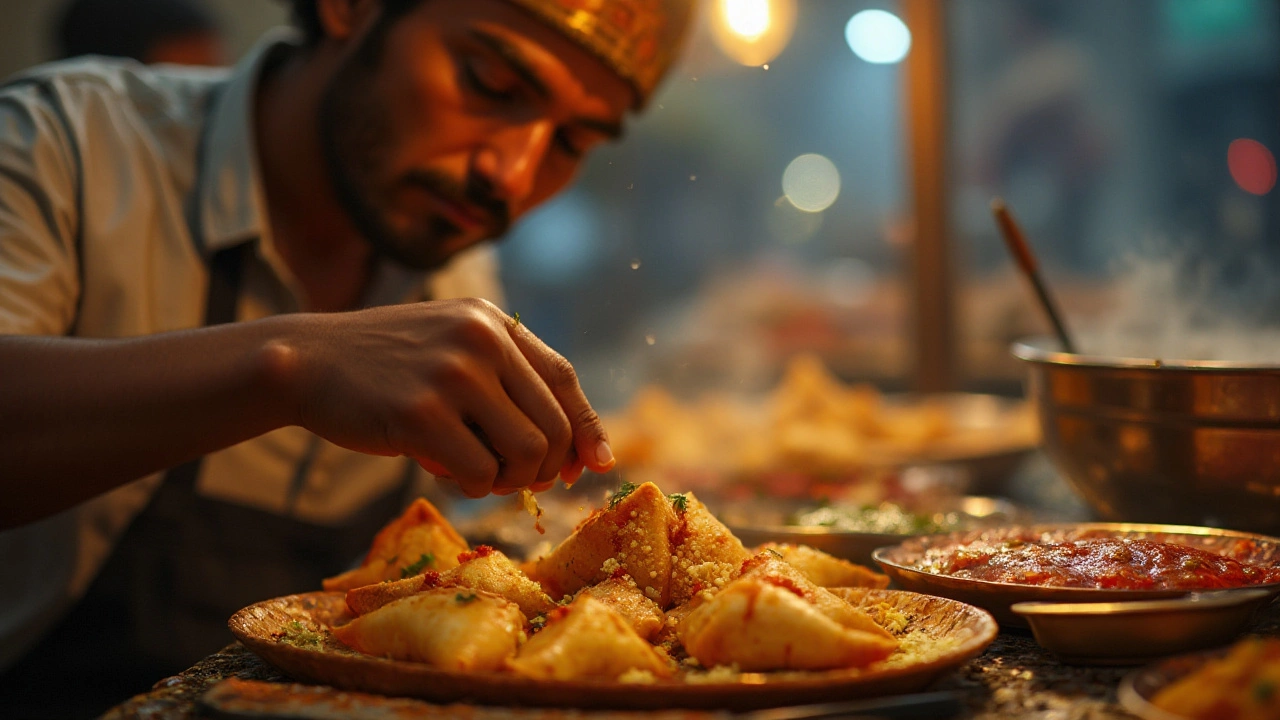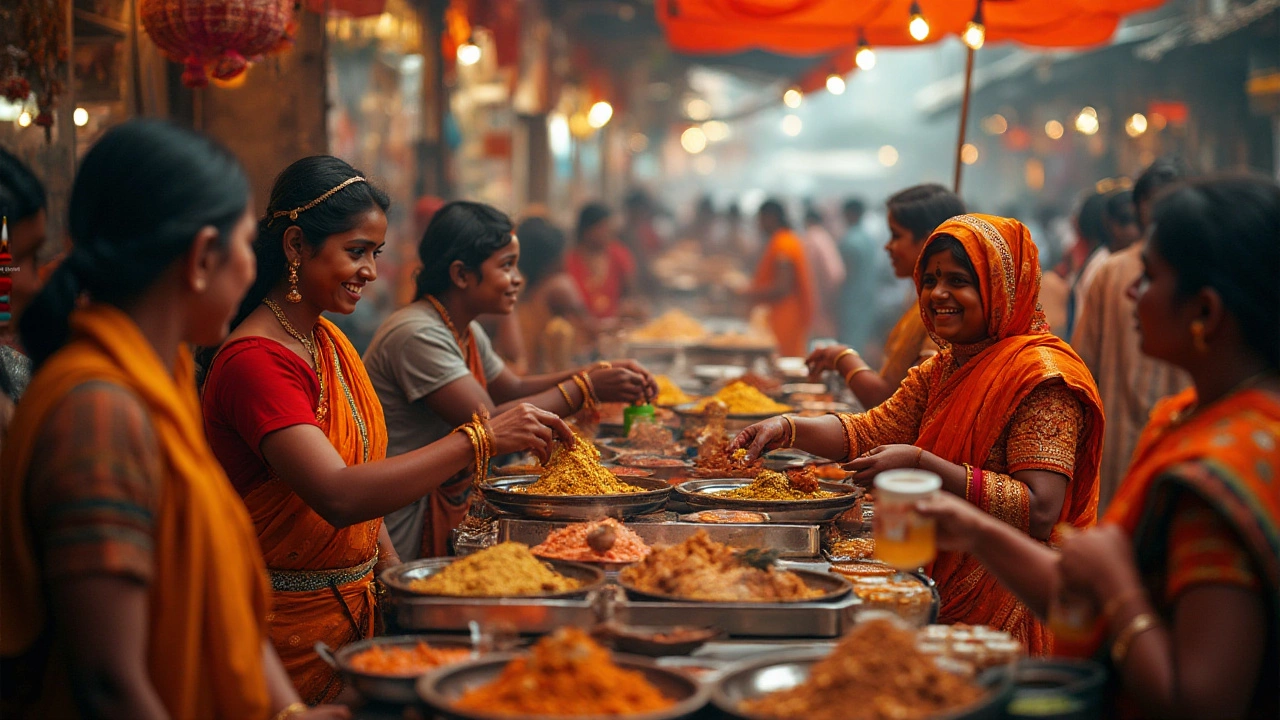4 Feb 2025
- 0 Comments
There's an unspoken thrill in sampling street food from an open-air vendor amidst the hustle and bustle of an Indian market. Vibrant aromas and sizzling sounds beckon you to a gastronomic adventure unlike any other. In a country where food is celebrated with reverence, knowing how to navigate the street food scene is both an art and a necessity.
While the choices are seemingly endless—each stall offering its unique twist on traditional delicacies—approaching the task with mindfulness can elevate your experience from mere sampling to true indulgence. Understanding local eating customs, assessing food safety practices, and mastering the art of eating with your hands are key components of immersing yourself in this vibrant dining culture.
- Customary Eating Practices
- Choosing the Right Vendor
- Essential Hygiene Tips
- The Art of Eating with Your Hands
Customary Eating Practices
India's sociocultural tapestry is intricately woven with its culinary traditions, where every bite carries a story and respect is embedded in every gesture. Embracing Indian street food isn't merely about savoring flavors; it involves understanding and participating in customary eating practices that enrich the experience.
Respect for Food
In Indian culture, food is often considered sacred. Many believe it is an offering from the divine, demanding gratitude and reverence. This is evident in the typical gesture of saying a short prayer or expression of thanks before starting a meal. While indulging in street food in India, exhibiting a similar respect by acknowledging the effort of vendors, who often have refined their recipes over generations, is always appreciated.
Eating with Hands
One of the quintessential practices is eating with hands, which is not only part of tradition but also engages multiple senses, enhancing the dining experience. The practice, however, is guided by specific etiquettes: it's customary to use the right hand for eating, as the left hand is reserved for less clean tasks. If you're new to this, start with something simple like panipuri or dosa, and watch locals to learn the finesse of breaking, folding, and scooping effectively.
The Science Behind It
Even modern studies suggest eating with hands can improve digestion by letting your body prepare itself for the arrival of food through sensory cues. This practice brings a sense of mindfulness, transforming meals into a more immersive experience. It's a dance between the delicate balance of food and fingers that brings you closer to the roots of Indian culinary artifacts.
Sharing is Caring
The concept of sharing is deeply ingrained in Indian dining practices. When traveling through India, it's not uncommon for locals to invite you to share a bite of their meal, showcasing hospitality and warmth. Whether at a busy street stall or a friend's home, sharing food is a gesture of goodwill and community bonding, reinforcing the belief that food, when shared, adds more flavor to life.
While navigating different regions, take note of regional idiosyncrasies in dining practices. For example, in the southern parts like Tamil Nadu and Kerala, meals are often served on banana leaves, which is believed to enhance flavor and add a sense of tradition to the meal. Respect for these local nuances will not only enrich your palate but also your cultural understanding.
Embracing these customary practices offers a gateway into the heart of Indian culture, where food is more than sustenance—it's an emotion, a tradition, and a legacy passed down through generations.
Choosing the Right Vendor
When embarking on a culinary exploration of Indian street food, one crucial decision-making step is choosing the right vendor. Amidst the cacophony of bustling markets and aromas drifting through the air, identifying a trustworthy stall can mean the difference between a delightful culinary experience and an unwanted gastrointestinal adventure.
Observe the Crowd
One of the simplest yet most effective strategies is to observe the crowd. As a rule of thumb, stalls with long lines are often a beacon of popularity and trust, indicating fresh and high turnover dishes. Seasoned travelers often echo the sentiment of experienced food writer Kunal Mehta, who says:
"The best dishes are often found where locals gather, so let the crowd be your guide."
Evaluate Hygiene Standards
Hygiene is paramount when it comes to enjoying street food in India safely. Look for vendors who handle food with gloves, use tongs or utensils instead of bare hands, and prioritize cleanliness in their workspace. Vendors who maintain spotless stands and practice evident sanitation measures are more likely to provide a safe dining experience.
Visual Checkpoints
- Avoid stalls near open waste or drainage areas.
- Look for vendors who cook food upon order, ensuring freshness.
- Notice if there is a system in place for storing and handling dishware.
Ask Locals for Recommendations
Local insight is invaluable in discovering authentic food gems. Ask residents or fellow travelers for recommendations—they often know where to find the best balance of flavor and safety. Indian food rules often revolve around instinct, kindness, and shared insights, so don't hesitate to engage in conversation.
| Tip | Why It's Important |
|---|---|
| Line Up with Locals | Indicates trusted taste and quality |
| Check Cleanliness | Ensures hygienic preparation and service |
| Talk to Locals | Offers first-hand experience about the best vendors |
By mastering the art of selecting the right street food vendor, you not only safeguard your wellbeing but also enhance your experience, turning each meal into a memorable story of flavor, culture, and human connection.

Essential Hygiene Tips
Enjoying Indian street food is an adventure for both your taste buds and your senses. However, ensuring that this culinary journey is both safe and pleasurable requires some attention to hygiene. When selecting a stall, look for vendors with high turnover as their ingredients are more likely to be fresh. Here are some practical tips to ensure a safe eating experience.
Choose the Right Vendor
Observe the food handling practices of the vendor. Stalls where the cook wears gloves or uses serving utensils are more desirable. High hygiene standards often reflect in the cleanliness of the stall itself. Busy stalls with long queues aren't just popular; they often have quick ingredient turnaround, minimizing the risk of contamination.
Time Your Visit
Plan to eat during traditional meal times when food is freshly prepared and demand is high, ensuring the ingredients haven't been sitting out for long. Avoid eating street food during monsoon months, as increased humidity can exacerbate food spoilage.
Stay Hydrated with Caution
While indulging in spicy fares, staying hydrated is essential. Stick to bottled water with intact seals, or consider carrying your own filtered water. Avoid ice in drinks unless made from purified water. It's common to find Indian beverages like lassi or sugarcane juice being prepared — ask about their water source before consuming.
Mind Your Sauces
Condiments often accompany Indian street food, adding depth to the dishes, but they can also be a hygiene risk. Opt for sauces that are securely stored and appear fresh. In some cases, asking the vendor to scrape fresh portions from underneath can reduce exposure to open air and potential contamination.
Exploring with Confidence
A simple scrutiny for cleanliness and maintaining personal hygiene—such as using hand sanitizers before eating—plays a vital role in enjoying the delectable streets of India. By following these hygiene tips, you can savor every bite while ensuring that your adventure is both delightful and safe.
The Art of Eating with Your Hands
For many outsiders, the tactile approach to enjoying a meal might seem unusual or even intimidating, yet in India, eating with your hands is a revered tradition. This age-old custom is not merely about the mechanics of feeding oneself; it's an expression of cultural heritage and a way to connect more profoundly with the food. In essence, using your hands invites a sensory experience where texture, temperature, and aroma blend harmoniously.
Eager to immerse yourself in this rich tradition? Here's how you can participate in this culinary custom while respecting the local etiquette:
Understanding the Significance
In Indian culture, food is seen as a sacred entity. Eating with your hands is a practice rooted in Ayurvedic principles, suggesting that touching food activates the five senses, enhancing the dining experience. When you engage physically with your meal, you develop a deeper appreciation for the textures and the artistry behind each dish.
The Right Hand Rule
The first rule of eating with your hands is to use your right hand. In Indian custom, the left hand is traditionally considered unclean, as it is typically reserved for personal hygiene tasks. Therefore, everything from scooping curries to tearing naan is done with the right hand, though the left hand can be used to assist by holding a cup or aiding in serving yourself more food.
Techniques and Tips
Mastering the art involves more than just using your fingers to shovel food; it's about finesse:
- Use your thumb and first two fingers to pick up and mix food.
- Form a small ball or mound of rice and curry using gentle pinching strokes.
- Catapult the whole bite into your mouth using your thumb.
In areas where rice is a staple, such as the southern states, practice the scooping and molding technique to enjoy rice dishes perfectly. Always maintain a clean thumb and fingers to avoid messiness, enhancing both hygiene and etiquette standards.
Enhancing the Experience
Eating with your hands can turn a simple meal into a sensorial delight. This approach brings a hands-on involvement to meals, encouraging slower, more thoughtful eating that revels in the explosion of flavors characteristic of Indian street food. Locals believe this practice also improves digestion and enjoyment overall.
Embarking on the hands-on journey of eating in India means more than savoring the taste—it invites you to share a universally acknowledged gesture of warmth and hospitality steeped in longstanding tradition. Make no mistake: the nuanced art of eating with your hands is an integral part of fully appreciating Indian street food's vibrant essence.
